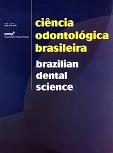Length assessment of titanium dental implants using different tomographic images *
DOI:
https://doi.org/10.14295/bds.2004.v7i1.407Abstract
Since the introduction of endosseous dental implant, diagnosis methods using images have been considered of great value. The anatomical structures of the elected area, the wells the relationship with adjacent tissues needs to be completely clears in the planning of implants, so it’s necessary to have accurate dimensions in the images of all anatomical structures involved. The aim of the present study was to evaluate different tomographic methods regarding to their precision for assessing the titanium implant length. The radiographs were taken of sixty fixed implants in edentulous areas of five human dry mandibles, using panoramic, film tomography and computerized techniques. The measures were made in all images using a digital paquimeter (Mitutoyo) in order to obtain the vertical dimension (lenght) of the implants. Image data was submitted to the statistical treatment, and it was demonstrated that there was great variation. In other words the same implant present variations in the image lenght comparing to the real dimension, depending upon the technique used. In relation to the accuracy of the technique for showing images closer to the real dimension, the results showed that there was the trend following order: computerized tomography (CT Sytec 3000), film tomography (Tomax) and panoramic (Panoura 10 CSU). The authors concluded that CT performs the best tomographic image of titanium implants followed by the film tomography and panoramic radiography, respectivel.
Downloads
Downloads
Published
How to Cite
Issue
Section
License
Brazilian Dental Science uses the Creative Commons (CC-BY 4.0) license, thus preserving the integrity of articles in an open access environment. The journal allows the author to retain publishing rights without restrictions.
=================




























